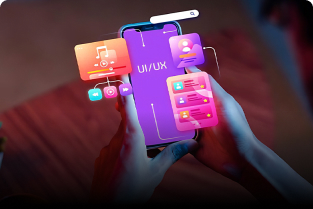Artificial Intelligence (AI) is transforming every industry, and UI/UX design is no exception. From automated layouts to smart user testing, AI is redefining how designers create digital experiences. But how exactly will AI impact the way we design for users? Let’s explore how this powerful technology is shaping the future of UI/UX design.
1. Smarter and Faster Design Processes
One of the most visible effects of AI in UI/UX design is automation. Tools powered by AI can now generate design elements, layouts, or even entire interfaces within seconds. Instead of spending hours perfecting a wireframe, designers can use AI assistants like Figma’s AI tools, Adobe Firefly, or Uizard to generate layouts and color palettes automatically.
This doesn’t replace the designer — it saves time by handling repetitive tasks so that designers can focus on creativity, strategy, and user empathy.
2. Personalized User Experiences
AI allows designers to create personalized experiences for every user. By analyzing user data — such as preferences, behavior, and location — AI can adapt interfaces in real time. For example, an e-commerce app could rearrange its homepage based on what a specific user is most likely to buy.
This personalization helps improve user satisfaction, retention, and conversion rates, turning digital interfaces into truly user-centered experiences.
3. Predictive and Data-Driven Design
Traditional design relies heavily on intuition, testing, and iteration. AI enhances this process by introducing predictive analytics. By analyzing how users interact with a design, AI can forecast which features or layouts are most effective.
This means UX decisions are no longer just “educated guesses.” Designers can rely on concrete, AI-driven insights to guide their design choices, ensuring a smoother and more intuitive user journey.
4. AI-Assisted User Testing
User testing is a crucial part of the UX process, but it can be time-consuming. AI simplifies this by automating usability testing. For instance, tools can now simulate user interactions, detect confusing navigation patterns, or predict where users might click — all before a design even goes live.
This allows designers to identify potential usability issues early and refine their designs faster and more accurately.
5. Voice and Conversational Interfaces
With the rise of voice assistants like Alexa, Siri, and Google Assistant, AI has expanded UI/UX design beyond visual interfaces. Designers now have to think about Voice User Interfaces (VUIs) and conversational UX — where tone, context, and natural language understanding play a key role.
AI makes it possible to create more natural and human-like interactions, enabling users to engage with technology through voice, text, or gesture instead of just tapping buttons.
6. AI-Powered Accessibility
Accessibility is a core principle of good UX. AI is making digital experiences more inclusive by automatically detecting and fixing accessibility issues. For example, AI can generate alt text for images, suggest better color contrasts, and even adapt interfaces for users with disabilities.
This ensures that technology becomes accessible to a wider range of users, creating a more equitable digital environment.
7. Creative Collaboration Between AI and Designers
AI is not here to replace designers — it’s here to collaborate with them. Think of AI as a creative partner that assists in brainstorming, speeding up prototyping, and testing design variations.
Designers still bring the essential human touch — empathy, storytelling, and emotional intelligence — while AI brings speed, precision, and data-driven insight. Together, they make a powerful team.
8. Ethical Challenges in AI-Driven Design
While AI offers incredible potential, it also introduces new challenges. Designers must consider data privacy, bias, and transparency when using AI. If not managed carefully, AI algorithms could unintentionally create unfair or misleading experiences.
As AI continues to evolve, ethical design will become an even greater responsibility for UI/UX professionals.
9. The Future of the Designer’s Role
In the AI-driven future, the role of the designer will evolve. Instead of manually creating every design element, designers will focus more on:
-
Understanding user psychology
-
Interpreting AI-generated insights
-
Ensuring ethical and inclusive design
-
Guiding AI systems with human creativity
In short, designers will become creative strategists who leverage AI to amplify their impact.
Conclusion
AI is not replacing UI/UX designers — it’s empowering them. By automating routine work, enabling personalization, and providing powerful insights, AI allows designers to create experiences that are smarter, faster, and more human-centered than ever before.

